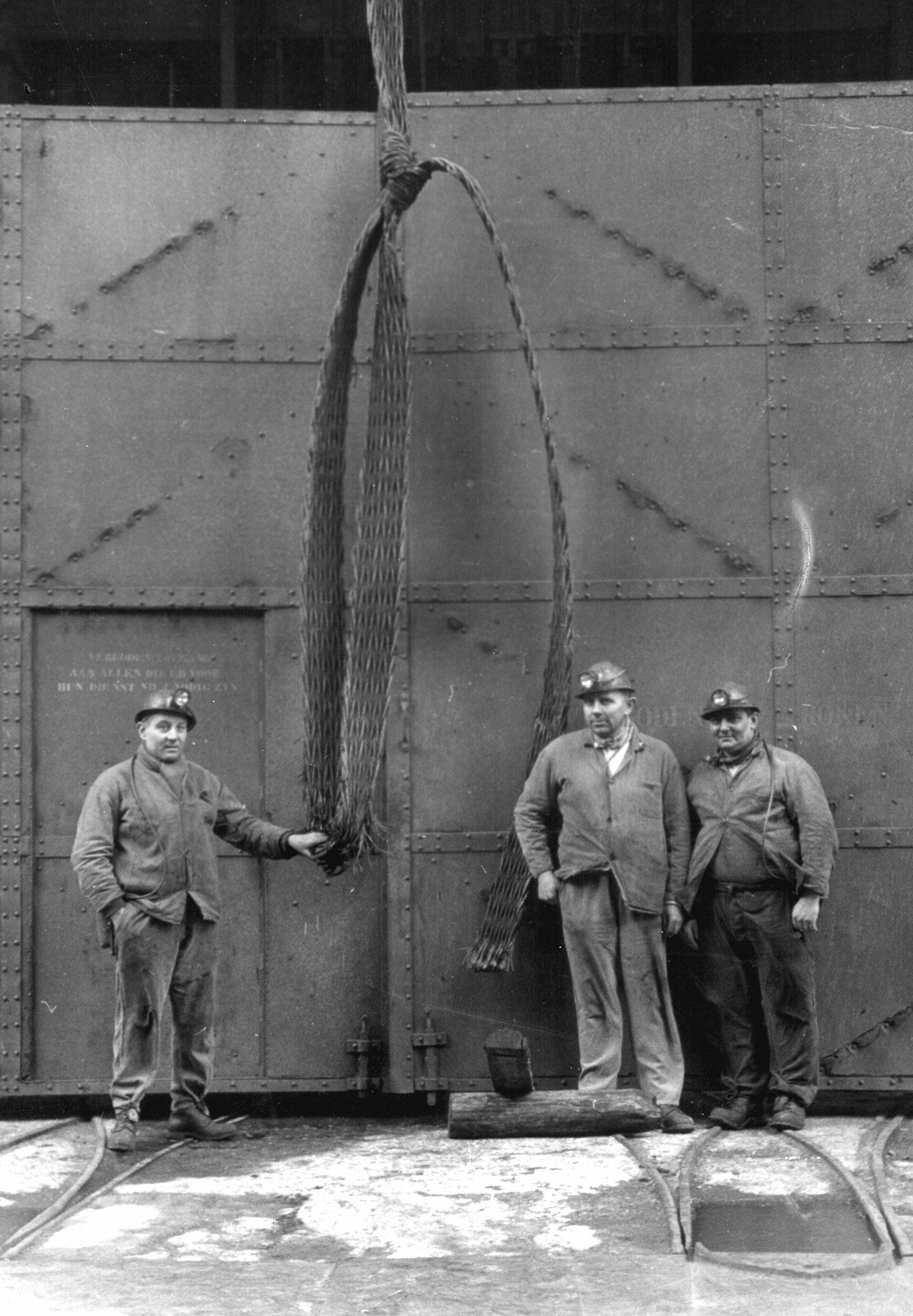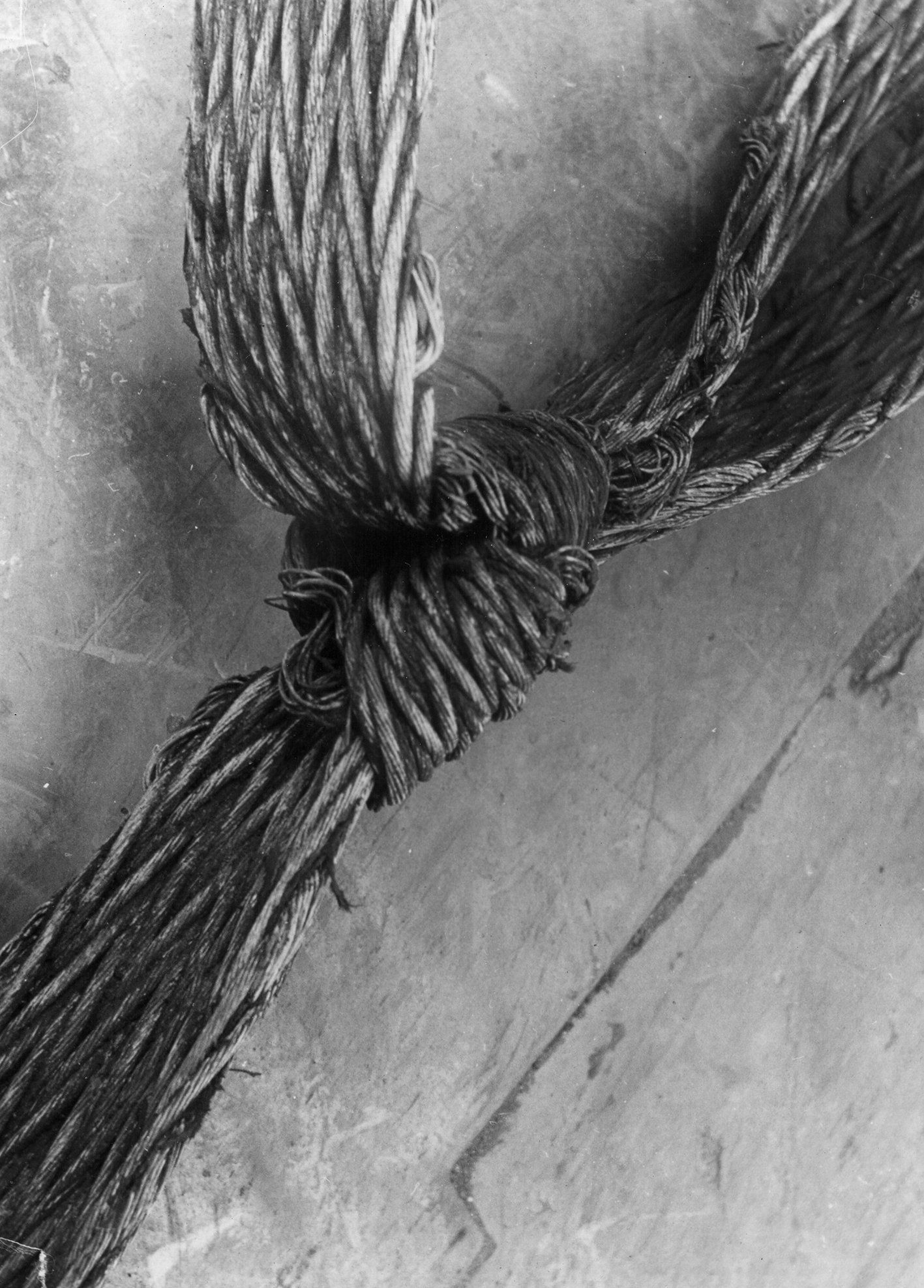7,5% ALC./VOL
Kompel Nostalgia Collection Batch NO.2 - Schachtknoop
"BEER MEETS WHISKY"
The best of both worlds combined in this Nostalgia Collection. Batch No.2 "Schachtknoop" is a golden blond beer with a fresh spicy profile and an extra complex character. The infusion of American oak logs from Whiskey Bourbon casks gives this special edition extra spice.
Release datum: 29.03.2021
Type Bier: WHisky Oaked (GOUDBLOND)
AVAILABILITY: 33cl
THE STORY:
THE SHAFT OR KRAVAT KNOT
A KNOT IN A CABLE?
At the end of 1960, at one o'clock in the morning, the telephone at home next to the bed rings: from the underground, 700 meters deep, the chief porion of the shafts calls on night mail:
“Machine 1 has come to a standstill and here at 700 everything is broken, all the poutriots and tracks jumbled and crooked, no one knows why! ”
The shafts, those two large round pits through which you descend to the underground, 800 meters deep, 6.10 meters in diameter, with watertight walls, pit riots, tracks for the cages, pipes, cables, ladders. Two hauling machines in each shaft, each machine serving two cages, one cage ascending while the other descends, counterweighting each other. Four cages in one shaft.
A world in itself, those two shafts, five thousand people go up and down them every day, in the cages. Only 12 shaft men work at night in the shafts, on top of the cages, on the pit riots and the ladder floors. In the light of their headlights they see the shaft around them, it is dark below them, but they know that there is a gaping hole there, 800 meters deep, which is why Louis always wore his belt with the safety chain. At the weekend, during the day, they see a point of light very high above them, the size of a postage stamp, there is the day, the topsoil.
AT 700 EVERYTHING BROKEN
So on the phone that night: “on 700 everything is broken and machine 1 has stopped!” Half an hour later, the shaft man is standing with a team of four on top of a cage of machine 2. We are going to search the shaft. The engineer slowly lowers us down the shaft. We look around in the light of our headlights. Next to us, the two cables of retrieval machine 1 hang motionless. Nothing abnormal to see, slowly it goes deeper. Up to 400 meters. Halt… our eyes pop out of our heads in amazement and disbelief. We see a knot in the flat cable, with a 2 meter long loop attached to it. A tightly tightened knot, not in a string but in a flat steel cable 15 cm wide and 2 cm thick. You can't believe this, but the knot is hanging there before our eyes. What the hell happened?
COLLECTION MACHINES: NOT JUST LIFTS
To understand it you need to know how collection machines work, a bit technical but still good to know.
Two hauling machines operate in each shaft and each machine operates two cages suspended together from a single round cable. The cable departs from cage 1 to 'the day', runs at the top of the headstock over one of those large wheels - the molets -, from there diagonally to the ground into the collection building, makes a half turn over the collection machine, back diagonally upwards over the adjacent molette and then down the shaft to the head of cage 2. The hauling machine pulls up the cable on one side and releases it on the other, one cage ascending while the other descends. They are each other's counterweight, that's important.
At the end of the ride, one cage is up, the other is down at 700.
THE ROUND AND THE FLAT CABLE
The lift cable is very heavy. He carries a cage of 20 tons. In the photo you can see a cut-out piece of cable, a wrist thick. One meter weighs 15 kilograms.
There is also a flat cable, what is it doing there?
Well, that flat cable is counterweight to the round cable. You should know, the cage below hangs from 700 meters of round cable and that cable itself weighs more than 10 tons. That 10 tons also requires a counterweight. To solve that they hang a flat cable under the top cage, which is as long as the shaft is deep, up to 25 meters below 700, there it takes a short turn and then rises to the bottom of the other cage. All that flat cable has to do is be the same weight as the round cable and go up and down simultaneously, just play counterweight. That is why it weighs the same, also 15 kilos per metre, but it is flat: 15 cm wide and 2 cm thick. It must be flat, it must be able to make a very short turn at lightning speed at the bottom, turn 180 degrees over only one meter wide.
THERE WE ARE, 400 METERS DEEP ON THE CAGE
And we stare at the knot and break our heads, what happened? We signal with bell cable plus bass - lower. Slowly we descend further to 700. There, indeed, everything is in disarray: pit riots and tracks, everything crooked and bent. We still don't understand. We descend further below the loading area of 700, through the ladders now.
And then we see it: ... something went wrong in 'the sawmill'.
THE SAWMY?
The cages fly up and down at 72 km/h, which is 20 meters per second. The flat cable descends to the bottom of the shaft, 25 meters below 700, where it rapidly makes a narrow turn only three feet wide and rises back up, pulled up by the rising cage.
The loop at the bottom would want to swing wildly back and forth. That is of course not allowed, which is why it is guided by heavy oak beams between which the ascending and descending cables are guided. The fast heavy cables gradually saw slots in the hard oak wood, which is why it was called 'the sawmill'.
A THICK STONE
But that night machine 1 is moving full speed. Machine 2 next to it is standing still: at 700 the cage is loaded with wagons of stones. The cars run into the cage and stop with a jerk. A thick stone falls from a wagon, rolls into the shaft and falls into the sawmill of the adjacent machine 1, which is in full motion. The flat cable is descending through the sawmill at lightning speed. The stone falls into the hole of the sawmill and gets stuck there …, the descending cable can no longer go through …, but it keeps coming and starts to pile up in loops on top of the sawmill …, below the sawmill the cable on the left no longer descends off …, but the cable continues to go up to the right …, the loop under the sawmill is eaten…
Now everything is lightning fast. It takes half a second and the loop under the sawmill is finished …, the cable is stuck against the underside of the sawmill …
Now something has to break, great violence, 30 tons in motion at 20 meters per second, you know. The flat cable is the strongest…, it throws the poutrels and oak beams of the sawmill into the air, like a house of cards.
One big mess and in between the stacked loops of cable swing upwards…, they get caught together…, one loop hooks behind the lower end of a vertical railway rail…, the cable still pulls on…, the knot is tightened. …, the ascending cable hangs with its loop. The cable does not break ..., the enormously strong hauling machine pulls on ..., it is the heavy construction of the loading area that is completely broken into a tangle of crooked poutrels and tracks.
It all took two seconds, 20 meters per second, you know.
The retrieval machine senses an overload, extends for another 300 meters and then stops. The knot hangs motionless at 400 meters.
But nobody knows that at the moment.
AND THEN... THE SHAFTMEN
First foreman will go to the phone, we will 'make shaft visit', we have to find the knot at 400 meters and the broken sawmill below 700.
And only then understand, stare at each other in disbelief.
It is then three o'clock in the morning.
At four o'clock in the morning the engineers come to have a look. The management also wants to see it.
Machien 1 will be shut down until the weekend, we cannot work while machine 2 has to collect full bins. In the weekend the flat cable will be replaced, the knot will be burned out and the shaft men will take an exclusive photo.
No one else in the history of mining, worldwide, will ever take a picture like this.
Between Friday evening and Monday morning, the shaft men will provide phenomenal proof of their craftsmanship and great commitment. On 700 they rebuild a completely new loading place and a new sawmill. Day and night they are busy, as they were every weekend.
Schachtmen experienced strange things. But a 'kravattenknot' in that super heavy cable ... That is still being told 50 years later.
Source: Eisden Heritage Foundation














